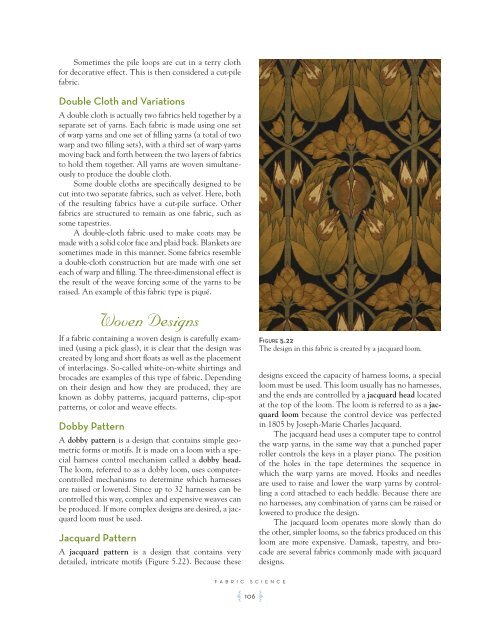Create successful ePaper yourself
Turn your PDF publications into a flip-book with our unique Google optimized e-Paper software.
Sometimes the pile loops are cut in a terry cloth<br />
for decorative effect. This is then considered a cut-pile<br />
fabric.<br />
Double Cloth and Variations<br />
A double cloth is actually two fabrics held together by a<br />
separate set of yarns. Each fabric is made using one set<br />
of warp yarns and one set of filling yarns (a total of two<br />
warp and two filling sets), with a third set of warp yarns<br />
moving back and forth between the two layers of fabrics<br />
to hold them together. All yarns are woven simultaneously<br />
to produce the double cloth.<br />
Some double cloths are specifically designed to be<br />
cut into two separate fabrics, such as velvet. Here, both<br />
of the resulting fabrics have a cut-pile surface. Other<br />
fabrics are structured to remain as one fabric, such as<br />
some tapestries.<br />
A double-cloth fabric used to make coats may be<br />
made with a solid color face and plaid back. Blankets are<br />
sometimes made in this manner. Some fabrics resemble<br />
a double-cloth construction but are made with one set<br />
each of warp and filling. The three-dimensional effect is<br />
the result of the weave forcing some of the yarns to be<br />
raised. An example of this fabric type is piqué.<br />
<strong>Woven</strong> Designs<br />
If a fabric containing a woven design is carefully examined<br />
(using a pick glass), it is clear that the design was<br />
created by long and short floats as well as the placement<br />
of interlacings. So-called white-on-white shirtings and<br />
brocades are examples of this type of fabric. Depending<br />
on their design and how they are produced, they are<br />
known as dobby patterns, jacquard patterns, clip-spot<br />
patterns, or color and weave effects.<br />
Dobby Pattern<br />
A dobby pattern is a design that contains simple geometric<br />
forms or motifs. It is made on a loom with a special<br />
harness control mechanism called a dobby head.<br />
The loom, referred to as a dobby loom, uses computercontrolled<br />
mechanisms to determine which harnesses<br />
are raised or lowered. Since up to 32 harnesses can be<br />
controlled this way, complex and expensive weaves can<br />
be produced. If more complex designs are desired, a jacquard<br />
loom must be used.<br />
Jacquard Pattern<br />
A jacquard pattern is a design that contains very<br />
detailed, intricate motifs (Figure 5.22). Because these<br />
FABRIC SCIENCE<br />
A 106 F<br />
Figure 5.22<br />
The design in this fabric is created by a jacquard loom.<br />
designs exceed the capacity of harness looms, a special<br />
loom must be used. This loom usually has no harnesses,<br />
and the ends are controlled by a jacquard head located<br />
at the top of the loom. The loom is referred to as a jacquard<br />
loom because the control device was perfected<br />
in 1805 by Joseph-Marie Charles Jacquard.<br />
The jacquard head uses a computer tape to control<br />
the warp yarns, in the same way that a punched paper<br />
roller controls the keys in a player piano. The position<br />
of the holes in the tape determines the sequence in<br />
which the warp yarns are moved. Hooks and needles<br />
are used to raise and lower the warp yarns by controlling<br />
a cord attached to each heddle. Because there are<br />
no harnesses, any combination of yarns can be raised or<br />
lowered to produce the design.<br />
The jacquard loom operates more slowly than do<br />
the other, simpler looms, so the fabrics produced on this<br />
loom are more expensive. Damask, tapestry, and brocade<br />
are several fabrics commonly made with jacquard<br />
designs.













